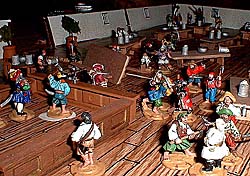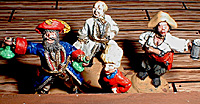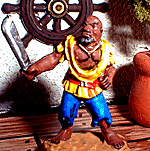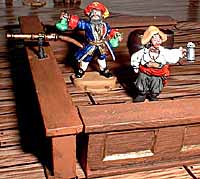
Cards
When using the standard blood and swash initiative rules we find that players have the bad habit of giving all their actions to their best pirate. This pirate moves all over, attacking everybody, while his mates stand around looking foolish. We use a different card system. Each player gets one card for each of his figures. When a figure's card is drawn that one figure gets an action. The player does not get to give the action to another figure. Each player also gets a wildcard. When the wild card is drawn the player may give one action to any of his surviving figures. We typically give each player four pirates. The pirate factions are usually distinguished by the color of their shirts.
Saving Throws and Hit Points
Pirates with high saving throws can be a real nuisance. Usually you have to back shoot them or knock them down before you can kill them. Even then it can take a long time. We use the following rules to make our fights faster (and bloodier). Pirates do not get a saving throw when they are deliberately hit with a weapon. If you are hit you take the damage, period. Pirates do get their normal saving throw against unusual weapons like grenades and swivel guns and others (see below for some new weapons). They also get their normal saving throw against stray bullets and saving throws are still used during movement (when called for in the rules). Because pirates don't get saving throws against most damage it is necessary to increase their hit points; otherwise your fights will be over too quickly. Every pirate gets an addition 6+1D6 hit points.
Pike Blocks
The town guards in our fights carry pikes (the governor is too cheap to buy muskets). Although not the ideal melee weapon for fighting in a bar they are useful for driving away rowdies and blocking doors. We've added some rules to the standard Blood & Swash pike rules to give the poor guards a fighting chance. Pike blocks move slowly (3") and carefully. They do not have to make saving throws for moving past obstacles, like dead pirates and beer spills. Pike blocks may move and attack in the same action. Any pikemen that end their move within 1 1/2 " of a figure may attempt to hit it.
New Weapons
 Whips
Whips
A whip does 1D6 points of damage. It also has the possibility of entangling an opponents weapon and disarming him. A character struck with a whip must pass a saving throw. If he fails the weapon in his hand is pried loose. It will take one action to retrieve the weapon. If the figure has a weapon in both hands roll to see which one was lost. A two handed weapon (musket, pike, etc.) cannot be pried loose in this manner.
Poison
Heathen savages are known to use poison blowgun darts and arrows. A victim of a poisoned missile must pass a saving throw to avoid the effects of the poison. If successful the victim take the normal damage for the missile. If the saving throw fails the victim has been poisoned and takes 1D6 points of additional damage. Moving about will make the poison work faster. Every time the victim takes an action he will receive 1D6 points of additional damage until he gets the antidote or dies. In order to give the pirates a sporting chance it's only fair that all poison using savages carry the antidote.
Personalities
 When we play Blood & Swash every figure is assumed to be armed with whatever the model is actually carrying. Of course this means everyone wants to use the Blackbeard figure with five pistols and a sword. But what about that beautiful figure armed only with a sword, that you lovingly painted? Poorly armed figures will collect dust as the players shun them in favor of better-armed models. We use a few house rules to make these figures more effective.
When we play Blood & Swash every figure is assumed to be armed with whatever the model is actually carrying. Of course this means everyone wants to use the Blackbeard figure with five pistols and a sword. But what about that beautiful figure armed only with a sword, that you lovingly painted? Poorly armed figures will collect dust as the players shun them in favor of better-armed models. We use a few house rules to make these figures more effective.
Specialists
Figures armed with only a single melee weapon (sword, axe, etc.) is considered to be a specialist. He is an expert in the use of his weapon and gets a +2 to-hit bonus with this weapon. He does not receive this bonus if he fights with two weapons.
Ambidextrous
Figures that are armed with two melee weapons (knives, swords, etc.) and no firearms are experts in fighting with both hands. They may swing with both weapons and do not receive the 1/2 to-hit modifier for their off-hand.
 Parrots and Monkeys
Parrots and Monkeys
Animals that are perched on the shoulders of a pirate aren't there just for show. Once per game the pirate may send his pet to attack an opponent. The attack can only be launched when the pet's owner's card comes up. The attack does not constitute an action, the pirate may still perform an action as normal. The target must be within 6". The animal will not cause any damage, but it will peck and scratch at the victim. No to-hit rolled is needed. Each time the victim has an action he must attempt to slug the animal with a normal to-hit roll. Until successful he may not perform any other action. This is a good time for his enemies to shoot and stab him. Once the victim makes a successful slug roll the animal is eliminated from play and the victim may act normally the next time his card is pulled.
Dirk
Dirk is a Foundry pirate armed only with three throwing knives. He is deadly accurate with his knives and delights in hitting his victim in vulnerable places. If he throws and hits with one of his knives the victim must make a saving throw. If the saving throw is successful the victim takes normal damage. If the saving throw fails the victim is dead. Dirk only gets to use this special rule with his first three knife throws.
Movement
 We've found that pirates in a crowded tavern fight have a lot of trouble moving around. We use a much more liberal set of rules for movement. A pirate may move 6" in one action. The pirate may follow any path as long as it isn't more the 6". The pirate may end his movement facing any direction he wishes. Pirates with peg legs move 1D6 inches per action. If the base of the pirate crosses any inanimate obstacles he must pass a saving throw to avoid falling. If a pirate falls he should always be placed on the other side of the obstacle. A pirate may not pass another figure if there isn't a gap equal to the figure's base. This rule allows pirates to block doors and trap opponents in corners.
We've found that pirates in a crowded tavern fight have a lot of trouble moving around. We use a much more liberal set of rules for movement. A pirate may move 6" in one action. The pirate may follow any path as long as it isn't more the 6". The pirate may end his movement facing any direction he wishes. Pirates with peg legs move 1D6 inches per action. If the base of the pirate crosses any inanimate obstacles he must pass a saving throw to avoid falling. If a pirate falls he should always be placed on the other side of the obstacle. A pirate may not pass another figure if there isn't a gap equal to the figure's base. This rule allows pirates to block doors and trap opponents in corners.
Minor Changes
In Blood & Swash all die rolls are made looking for less than the needed number. If you roll equal to your attribute you fail. In our club we lower all attributes by one point and roll for less than or equal to the needed number. This is a small change but it seems more natural than the standard rule. This way you don't have to see the disappointed look on the face of a player when you point out that, since he rolled equal to his attribute, he has failed, not succeeded, at an action.
Back to SJCW The Volunteer Fall 2000 Table of Contents
Back to SJCW The Volunteer List of Issues
Back to Master Magazine List
© Copyright 2000 by SJCW
This article appears in MagWeb (Magazine Web) on the Internet World Wide Web.
Other military history articles and gaming articles are available at http://www.magweb.com